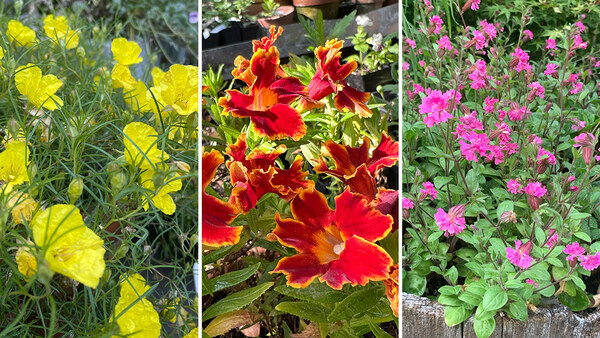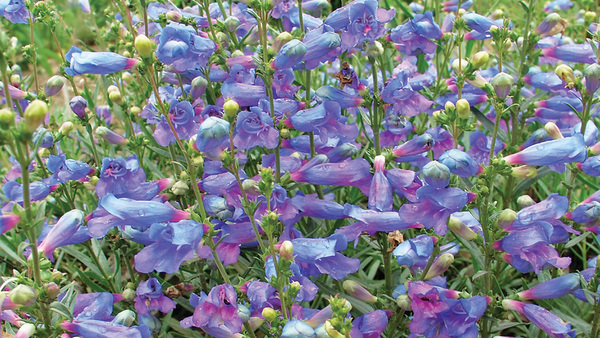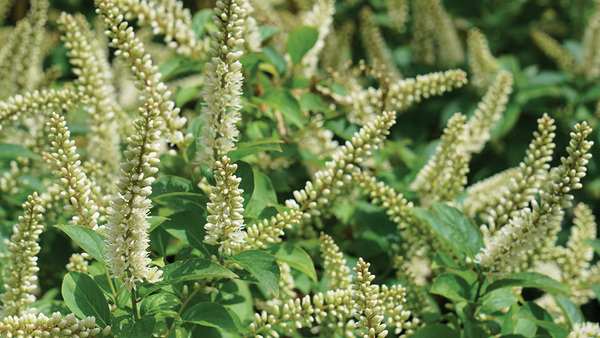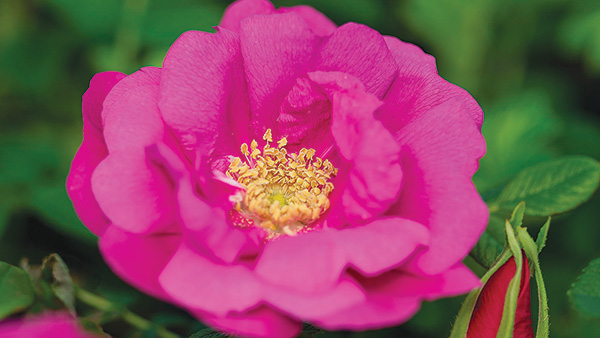
It’s not often that a new genus goes mainstream. In 2021 we received Ladybird® Sunglow Texas primrose as a trial plant from Proven Winners, and it quickly proved itself to indeed be a winner. Its pure, radiant yellow flowers provide an effortless dose of brightness to the garden. These four-petaled, 2-inch-wide blossoms float among soft, feathery green foliage. As the blooms fade they turn a deep yellow to apricot, adding to the appeal. They are self-cleaning and bloom vigorously all summer without any deadheading, attracting bees, birds, and butterflies.
Ladybird® Sunglow’s soft needlelike foliage provides an interesting texture on a low-growing form. The common name Texas primrose comes from the genus Calylophus being native to Texas and from being in the same family as our native Oenothera species. Native to the Southwest, Texas primrose grows in wild areas that experience low humidity and periods of drought, but Ladybird® Sunglow doesn’t skip a beat in the humidity of Tennessee. This selection works great when planted in the ground at the front of a border or spilling over the edge of a container. It grows best with six or more hours of sunlight and well-drained average to lean soil. Heat tolerant, drought tolerant, and deer resistant, Ladybird® Sunglow is generally free from pests and other problems. The only reason it might fail would be poorly draining soil or overwatering.
In container plantings and beds, Ladybird® Sunglow mixes beautifully with other low-water-consuming plants, such as Soiree Kawaii® series vinca (Catharanthus cvs., Zones 10–11), Crystal™ White zinnia (Zinnia angustifolia ‘Crystal White’, annual), and Augusta™ Lavender heliotrope (Heliotropium ‘WNHPAULAV’, Zones 8–11). When you grow it in pots, treat this Texas primrose as you would most others that do not require much water. Apply one dose of slow-release plant food at planting time and a water-soluble fertilizer once or twice during the growing season to keep plants blooming all summer long. In areas with a long growing season, cut back Ladybird® Sunglow by one-third if it starts looking a bit straggly. This will encourage new growth with more blooms and a well-branched form. Although it is listed as hardy to Zone 8 (10° to 15°F), the original planting at the University of Tennessee Gardens Jackson (Zone 7) has come back each spring since it was planted in 2021, even with temperatures that dipped briefly below 0°F. Good-draining soil is crucial for overwintering this plant, particularly in marginal areas. Add Ladybird® Sunglow to your garden and it will surely brighten your summer.
Ladybird® Sunglow Texas primrose
Calylophus ‘WNCYLASUN’
Zones: 8–10
Conditions: Full sun; well-drained soil
Native range: Southwestern United States
Jason Reeves has been putting plants to the test at the University of Tennessee in Jackson since 2002 and can be followed on Facebook at “Jason Reeves – in the garden.”
Illustration: Elara Tanguy
Sources
- Garden Crossings, Zeeland, MI; 616-875-6355; gardencrossings.com
- Grimm’s Gardens, Hiawatha, KS; 785-459-2586; grimmsgardens.com
Check out more super cool plants:
‘Electric Blue’ Foothill Penstemon Is a Tough Native with a Unique Hue
Fizzy Mizzy® Virginia Sweetspire Is a Compact Native Shrub with Pollinator Power
Fine Gardening Recommended Products

ARS Telescoping Long Reach Pruner
Fine Gardening receives a commission for items purchased through links on this site, including Amazon Associates and other affiliate advertising programs.

Gardena 3103 Combisystem 12-Inch To 20-Inch Adjustable Metal Fan Rake Head
Fine Gardening receives a commission for items purchased through links on this site, including Amazon Associates and other affiliate advertising programs.

Spear & Jackson 4930FZ Razorsharp Telescopic Tree Pruner
Fine Gardening receives a commission for items purchased through links on this site, including Amazon Associates and other affiliate advertising programs.




















Comments
Log in or create an account to post a comment.
Sign up Log in